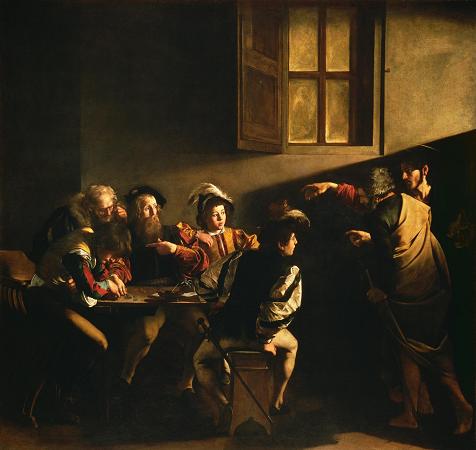Calling of Matthew. The Calling of Matthew is an episode in the life of Jesus which appears in all three synoptic gospels, Matthew 9:9-13, Mark 2:13-17 and Luke 5:27-28, and relates the initial encounter between Jesus and Matthew, the tax collector who became a disciple. According to the Gospel of Matthew: As Jesus went on from there, he saw a man named Matthew sitting at the tax collector's booth. Follow me, he told him, and Matthew got up and followed him. A tax collector could be either an independent contractor with the Roman government, who paid a fee to Rome to obtain the right to extract taxes from the people in a certain area, with an added fee for the collector and his employees; or he might have also been a toll collector for Herod Antipas, Capernaum was an area with a high traffic of people and merchants. In any case, Levi-Matthew would have been a very unpopular individual. The Greek: is often translated as the tax collector's booth or tax office. The King James Version says Matthew was sitting at the receipt of custom. Wycliffe's translation was sitting in a tollbooth, and the Expanded Bible suggests that the telonion was probably a tariff booth for taxing goods in transit. In all three synoptic gospels, this episode takes place shortly after the miracle of healing the paralytic at Capernaum and is followed by Jesus' image of the danger of putting new wine into old wineskins. In the Gospels of Mark and Luke, the person called is called Levi, who was the son of Alpheus according to Mark. Also in all three synoptic accounts Jesus is then invited to a banquet, with a crowd of tax collectors and others. The Pharisees then complain: Then Levi held a great banquet for Jesus at his house, and a large crowd of tax collectors and others were eating with them. 30 But the Pharisees and the teachers of the law who belonged to their sect complained to his disciples, Why do you eat and drink with tax collectors and sinners? 31 Jesus answered them, It is not the healthy who need a doctor, but the sick. 32 I have not come to call the righteous, but sinners to repentance. The calling of Matthew has been the subject of works of art by several painters, including: Caravaggio at Contarelli Chapel in the church of San Luigi dei Francesi in Rome, Hendrick ter Brugghen, Juan de Pareja.
more...









